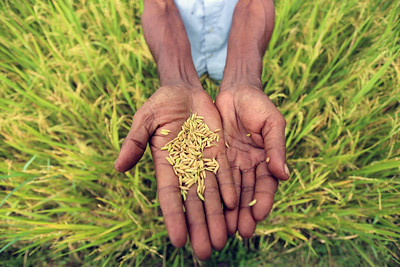Despite the efforts made under the auspices of the UN Sustainable Development Goals (SDGs) to end hunger by 2030, global food production would still have to be increased by as much as 70 percent to achieve this. However, using a nuclear technique known as plant mutation breeding, scientists can use radiation to produce seeds that are more resistant to drought, disease and adverse weather conditions, have shorter crop cycles, higher yields, and other beneficial traits.
On 1 April 2021, the VCDNP held a webinar to discuss the contribution of innovative technologies to sustainable agriculture, including the support provided by the International Atomic Energy Agency (IAEA) and IAEA Member State experiences in this regard. The recording of the webinar is below.
The webinar built on a case study, published by the VCDNP that examines how the use of nuclear techniques for plant mutation breeding has improved crop production and the livelihoods of farmers across the globe. The webinar also considered how access to radiation technology can be expanded in a safe, secure, and sustainable manner to contribute to achieving other SDGs by 2030. The webinar attracted more than 100 participants from more than 70 countries, including diplomats, international civil servants, practitioners, academics, and experts in agriculture and food security. The panel discussion was moderated by VCDNP Senior Research Associate Ingrid Kirsten. The panelists were:
- Mr. Ivan Ingelbrecht, Head of the Plant Breeding and Genetics Laboratory of the Joint Division of the IAEA and the UN Food and Agriculture Division (IAEA/FAO Joint Division);
- Dr. Md. Abul Kalam Azad, Director at the Bangladesh Institute of Nuclear Agriculture;
- Dr. Luz Gomez, Principal Professor and Head of the Cereals and Native Grains Research Program of Universidad Nacional Agraria La Molina in Peru;
- Professor Tomoko Abe, Head of Laboratory at the RIKEN Nishina Center for Accelerator-Based Science in Japan;
- Dr. Suresh Pillai, Director of the National Center for Electron Beam Research at Texas A&M University (a designated IAEA Collaborating Centre).
Presentations
Mr. Ingelbrecht also highlighted the support provided by the IAEA to Member States. The Agency’s technical cooperation (TC) programme is the IAEA’s primary mechanism to transfer nuclear technology to Member States and to help them to address key development priorities in areas such as health and nutrition, food and agriculture, water, and the environment, industrial applications, and nuclear knowledge development and management. The IAEA has 53 national technical cooperation projects, 11 regional TC projects, and five Coordinated Research Projects with five-year implementation periods.
Dr. Gomez explained how plant mutation breeding has improved crop yield and quality, as well as the livelihoods of farmers in Peru. Peruvian farmers face numerous challenges including extreme climate conditions, such as drought and floods. Moreover, agriculture production takes place at 3000 and 4000 meters above sea level on small plots. Using irradiation Dr Gomez has been able to improve the production of cereals and natural grains. Centenario is a variety of Amaranth that was mutated to improve yield potential and tolerance to salt. This has increased yield by 1100 kilograms (kg) per hectare. At $0.40 per kg that means $440 per hectare additional income per year. Centenario is adding $6,600,000 to the national economy yearly. Considering all nine barley varieties that have been improved with mutation breeding, the contribution to the national economy of Peru is close to $18,000,000. Ensuring the uptake of these seeds by farmers is a key element of the successful and sustainable application of this technology. In Peru, gamma irradiators are used for the irradiation of seeds and plant material.
She listed the following advantages of fast heavy-ion beam irradiation for mutation breeding:
• Irradiation treatment can be given to various plant materials smaller than 9 centimetres in diameter;
• High mutation rates and a wide variety of mutants can be taken, even at low doses;
• Short irradiation time, from seconds to a few minutes;
• Less harm to the plants and damages fewer genes, thus requiring less time for breeding;
• Discovering novel genes using mutants;
• New genes can be targeted for genome editing.
She noted that mutagenomics – the discovery of genes using the combination of mutants and genome sequencing – is becoming increasingly useful and important in modern genetic studies.
Discussion
During the discussions Mr. Ingelbrecht agreed that the potential of alternative technologies should be harnessed and noted that that the IAEA is acquiring a combined e-beam/x-ray machine for the Plant Breeding and Genetics Laboratory. He also encouraged more partnerships and collaboration in the field of plant mutation breeding to maximise the benefits for this technology for developing countries.
Regarding questions related to the upscaling of the technology to address food safety and food security needs, Dr. Pillai said that the private sector will spearhead the scaling up of this these technologies if governments create a favourable environment by approaching the technology and ensuring that the required regulations are in place to enable the use of these technologies.
Dr. Gomez pointed out that working with farmers to ensure the uptake of new varieties is essential to the sustainable application of this technology. In Bangladesh, the successful distribution of seeds and the uptake of new varieties also a key building block in the sustainable application of mutation breeding for crop improvement and socioeconomic development.

